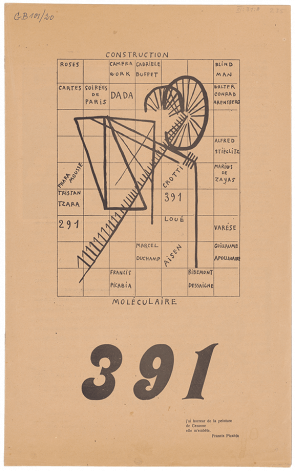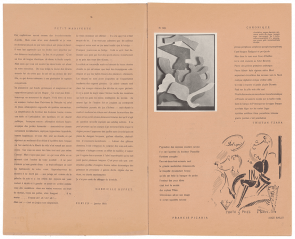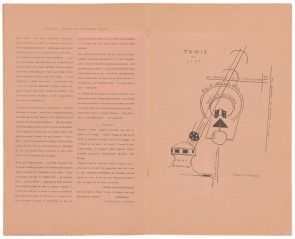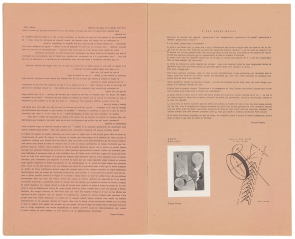From autumn 1918, Francis Picabia stayed at the spa Bex-les-Bains in Vaud, torn between his mistress and his family and afflicted with neurasthenia, the burnout syndrome typical of that time, from which other Dadaists also suffered. After Tristan Tzara had got in touch with him, Picabia, the Dadaist “funny guy,” was keen to experience the adventure Dada on site and decided to stay in a hotel in Zurich for two weeks. Some of his mechanomorphic pictures, which had been rejected by the Kunstsalon Wolfsberg as too modern, were presented in the exhibition Das Neue Leben (The New Life) at the Kunsthaus. He had already made some contributions to Dada 3 some months before. During his short stay in Zurich, Picabia saw to having some material in the pipeline for Dada 4–5, such as a drawing in which he sketched the rise and status of the Mouvement Dada in a ladder of names, establishing a mechanical connection with his magazine 391.
With the eighth number of 391—nineteen issues of the magazine came out between 1917 and 1924—Picabia added another stop to his “journal en voyage” in February 1919 by extending the range of its places of publication (Barcelona, New York, Paris) to Zurich. His stereotyped line drawing Construction moléculaire (Molecular Construction) on the cover unfolds a partial visual synthesis of his universe, which now also included Tzara, to whom he assigned a place of honour right below his pseudonym “Pharamousse.” His wife, Gabrielle Buffet, who accompanied him to Zurich, is also present in the drawing. Her Petit Manifeste, the rhetoric of which evokes that of Tzara, provides the prelude for the number. Personal and intimate will-o’-the-wisps reflecting the close network of relationships and the context of the art of life and love feature prominently in Dadaist magazines and particularly in the notes accompanying them. The illustrated part of the Zurich edition of 391 is almost exclusively comprised of Picabia’s presented “dessins méchanomorphes” and “dessins poèmes” which he also used for his poetry booklets published in Lausanne. The Geneva artist Alice Bailly’s portrait of Picabia comes as a surprise; she presented her works together with those of Picabia at the Kunsthaus after she had done so in Paris. Next to Sophie Taeuber, Bailly was the second Swiss woman artist who was to be admitted to the Olympus of Dada “Présidents et Présidentes.”
Knowing Picabia definitely further opened the door to France for the Dadaists in their Zurich exile and especially for Tzara. Shipping a substantial number of copies of Dada 3 to Paris, Picabia ensured comprehensive publicity. His later sudden official retirement from the circle of Dadaists was partly due to his mobility and independence as an artist. He always sought not only a change of place but also of atmosphere and spirit. “Notre tête est ronde pour permettre à la pensée de changer de direction” (Our heads are round so our thoughts can change direction) (La Pomme de Pins, Paris 1922).
Edition: 1,000 copies. Pink paper. The illustrations by Hans Arp on page 3 and Picabia on page 7 are pasted-in halftones. Provenance: 391, no. 8 was purchased by the Kunsthaus Zürich at the auction “Items from the Library and Collection of Tristan Tzara (Kornfeld & Klipstein, Dokumentations-Bibliothek III, Bern)” in 1968.





